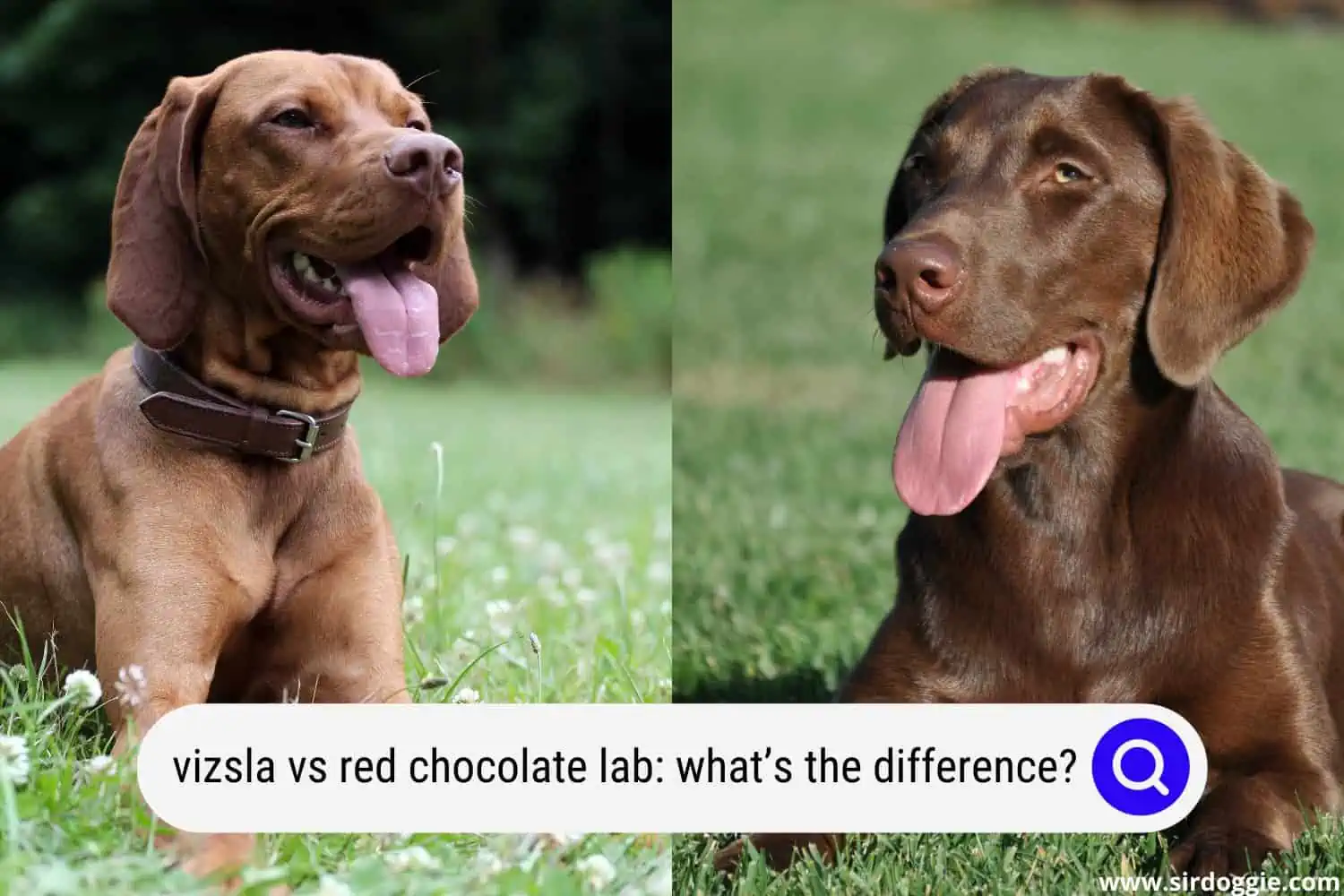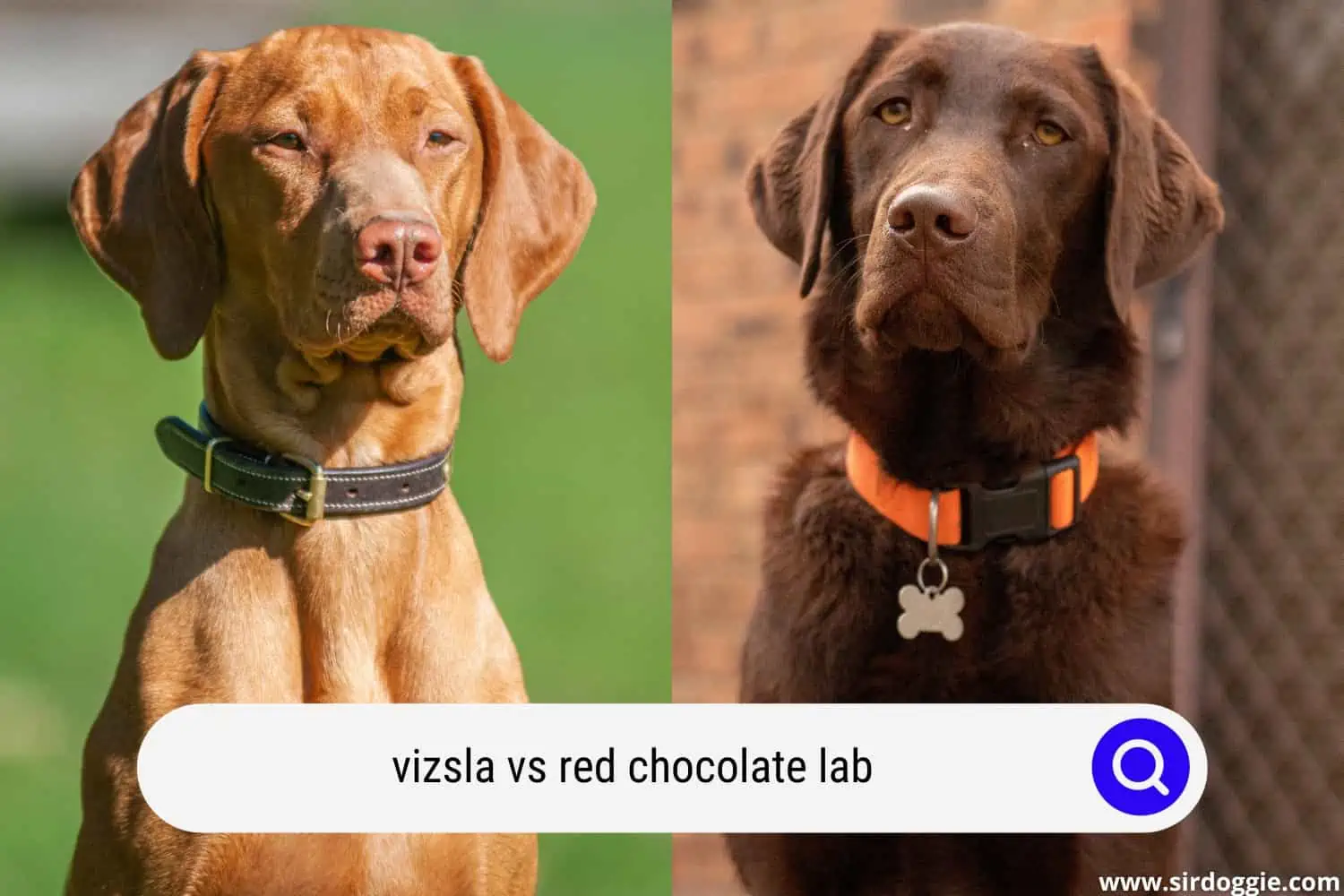Vizsla vs Chocolate Lab: What’s the Difference?
The Vizsla and the Chocolate Lab are two distinct dogs. The Vizsla, also called the Hungarian pointer, is a pointing dog from Hungary. Meanwhile, the Chocolate Lab, also known as the Labrador Retriever is a strong and robust report, lifting, and water dog that originated from England and Canada.

While they are both characterized as large dogs, the Chocolate Lab is heavier, while the Vizsla is taller. In what other ways do they differ from each other? In this Vizsla vs. Chocolate Lab comparison article, we will review each dog individually and try to see which is the best among the two by comparing their characteristics.
The Chocolate Lab
The Chocolate Lab is a very robust and strong dog that is very heavy. Its head is usually proportional to its body dimensions. It’s well modeled, and lean, with little fleshy cheeks. Its eyes are dark hazel or medium brown, with intelligent expressions.
The ears are not heavy or large, they are however set back a little.
The coat is short, thick, without bangs, but rather coarse. The dog’s undercoat is weather-resistant because it is dense.
The male can only be 57 cm maximum in size while the female can reach 55 cm maximum. The average weight is about 30 kilograms.
The Chocolate Lab Origin
In 19th-century works of literature, the names “Labrador” and “Newfoundland” are used often while referring to the water dogs of the Canadian coasts. The Labrador’s ancestor is most likely the “St John’s Dog.” This is a smaller type of the Newfoundland dog which was raised in Canada during the same period as with this dog. The breed later spread widely in Great Britain and it was in this country that they obtained the paternity.
The Chocolate Lab Character
It is a very gentle dog that is affectionate to the members of its social group. Very sociable, it makes friends easily. It is a friendly, cheerful, and playful dog. It’s particularly suitable for reporting games.
Never aggressive, the dog is really sociable, in addition to strangers. Although the puppy of the Labrador can be a bit more difficult to train, as an adult, they are a very pleasant dog to train and work with. The educational bases must be initiated early. However, training is relatively easy.
The dog barks, but it’s not excessively… except if it is left alone in the yard every time without ever coming out. This dog is very greedy. Because of this, it is important to watch its diet to prevent it from becoming obese.
The Chocolate Lab Compatibility
Although the predatory instinct is really important for some, it remains “easy” to manage. Living with another pet such as a cat is generally not a problem, especially if the puppy is trained from a young age to a feline presence.
The dog is safe for kids who are a bit older. However, it can be a bit too brusque for the little ones. It’s necessary to educate your kids about the canines so they can all live in good harmony.
The dog isn’t ideal for being with seniors or the elderly. Even though it can adapt to a lot of situations, a daily lifestyle in one place would not suit this playful and active dog. It needs a lot of exercise and activity so it can feel good.
The Chocolate Lab Health
This dog is very robust but it is often prone to obesity due to its dietary attitude. This, sometimes, may lead to health issues that are serious. Hence it has a shorter lifespan (10 to 12 years) than the Vizsla.
In summer, don’t put too much strain on the dog physically as it could suffer from the heat. A corner of shade with clean water will guarantee comfort. Its thick undercoat allows it good weather resistance but also good waterproofing (and luckily since it loves water).
Some of its most recurring health issues are:
- Hip and elbow dysplasia
- Progressive retinal atrophy
- Retinal dysplasia
- Cataract
- Neuromuscular disease
Vizsla Dog
The Vizsla is a very beautiful dog of a large size too. It has a noble appearance, with light bone, lean muscles, and sinews of steel. It gives the impression of being a true athlete built to run. There are two types of Vizsla: the shorthaired pointer and the wirehaired pointer. The Vizsla eyes are oval, as dark as possible, with an intelligent expression.
The ears are placed slightly behind and worn flattened against the cheeks. The limbs are straight and perfectly upright: the hind limbs form a fairly open angle. The tail can be cut to two-thirds of its length and is carried horizontally.
Vizsla Dog Origins and History
Very little is known about its origins: it may have come from the cross between a Hungarian Hound (the short-legged Transylvanian or the Pannonian Hound) and a yellow hunting dog of Turkish origin.
The breed commonly referred to as Hungarian pointer probably originated in the 17th century, but reached its present form during the 19th century through various crosses with other foreign breeds.
Vizsla Dog Character
This pointing dog is very close to its social group and loyal to its owner. As comfortable outside when working alongside its master as inside, it can adapt to all lifestyles and appreciates the comfort of a home.
Always active and of a jovial nature, Braque likes to play and particularly appreciates all games that require thought (intelligence games, search games, etc.).
Like many working dogs, this Hungarian dog is very clever and knows how to use its skills for the benefit of the missions it’s entrusted to. A hunting dog par excellence, it is versatile and can adapt to all terrains, even the most difficult. On the plain, in wood, or water, it expresses all its potential with elegance, endurance, and determination.
Never shy or aggressive, the Vizsla welcomes guests to its home and is also sociable with people it meets on a walk.
If the Vizsla puppy is accustomed from an early age to being alone at home, it can quite endure, even as an adult, the absence of its owners. Be careful though, this working dog needs a lot of stimulation, both physical and mental, and can therefore quickly get bored.
The Vizsla is renowned for being very docile and easy to train. This working dog is obedient and loves to learn and to please its master. It is a very pleasant companion who readily cooperates, especially if the attitude of its master is consistent, benevolent, and fair.
Brutality doesn’t work with this sensitive dog who, no pun intended, points out at the slightest hint of violence, whether physical or psychological.
Like any good self-respecting pointer, this dog barks easily and can quickly become excessive if not corrected from a young age as a Hungarian pointer puppy.
Vizsla Dog Compatibility
Against all expectations, this hunting dog can quite get along with the feline species. However, it is better if it grew up with a cat to consider it a full member of its social group.
Very sociable, it is very rare for this dog to initiate fights with its congeners.
The Magyar Vizsla, as it is called in its home country, adores children and enjoys spending time with them as long as they respect the dog and also learn to leave it alone when ‘it is resting in its basket.”
Vizsla Dog Health
The short-haired pointer’s lack of undercoat allows it not to suffer from the heat. However, it is preferable not to make it exercise too intensely in summer. Since it loves water, walks around water points are recommended.
This dog can endure inclement weather without a problem. It can also live outside and is not afraid of the cold. The Vizsla has little tendency to gain weight. It is only dogs that do not have enough physical exertion that can be prone to obesity.
Some of the frequent illnesses of the Vizsla are:
- Hip dysplasia
- Eye damage
Comparison Table: Vizsla vs Chocolate Lab
| Names | Vizsla | Chocolate Lab |
| Breed Type | Purebred | Purebred |
| Origin | Hungary | England, Canada |
| Price | $800 to $1200 | $1000 to $2000 |
| Size of dog | Large | Large |
| Fur | Fine, Dense, Coarse, Short, Hard, No Undercoat | Dense, hard, short, waterproof |
| Grooming | Minimal | Minimal |
| Shedding Level | Moderate | Moderately |
| Intelligence level | Very smart | One of the smartest dogs |
| Friendliness | Stranger-friendly, kids-friendly, averagely friendly to cats and other dogs, not office-friendly, elderly-friendly | Stranger friendly, very kids friendly, friendly to cats, very friendly to other dogs, not office-friendly, elderly-friendly |
| Trainability | Easy to train | Very easy to train |
| Life expectancy | 10 to 14 years | 10 to 12 years |
| Exercise needs | Requires a lot | Requires a lot of exercises |
| Drooling | Minimal | Average drooler |

Conclusion
As you can see, both dog breeds have characters and characteristics that make them great dogs for companionship at home and for hunting. However, if you need a dog with few health concerns, choose the Vizsla.
The chocolate Lab is prone to several health issues and will require regular visits to the vet. The Vizsla is more popular and widely available for a lower price not exceeding $1,200. However, the Chocolate Lab is rarer and more expensive.

Family Dog Expert Author
Hi there! I’m Stuart, a devoted dog lover and family dog expert with over a decade of experience working with our furry companions. My passion for dogs drives me to share my knowledge and expertise, helping families build strong, loving bonds with their four-legged friends. When I’m not writing for SirDoggie, you’ll find me hiking, playing with my beautiful dog, or studying music.